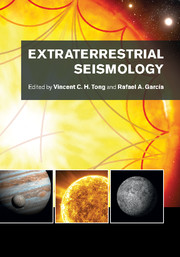Book contents
- Frontmatter
- Contents
- List of contributors
- Preface
- Acknowledgements
- List of abbreviations
- Planetary seismology: High risk, high return
- A bright outlook for helio- and asteroseismology
- Part I Observation and space missions
- Part II Data and physical parameters
- Part III Modeling approaches
- Part IV Discoveries of physical structures and processes
- Part V Interdisciplinary research involving planetary and astrophysical sciences
- 16 Diskoseismology of accretion disks
- 17 Numerical simulations of magnetoconvection and helioseismology
- 18 Impact seismology on terrestrial and giant planets
- 19 Angular momentum transport in stars: From short to long time scales
- 20 From the Sun to the distant stars, and back: Future research directions
- 21 Stellar dynamics: Rotation, convection, and magnetic fields
- 22 Sunquakes: Helioseismic response to solar flares
- 23 Seismic waves in small bodies: Sources and propagation
- Part VI Interdisciplinary research involving terrestrial seismology
- References
- Index
21 - Stellar dynamics: Rotation, convection, and magnetic fields
from Part V - Interdisciplinary research involving planetary and astrophysical sciences
Published online by Cambridge University Press: 05 July 2015
- Frontmatter
- Contents
- List of contributors
- Preface
- Acknowledgements
- List of abbreviations
- Planetary seismology: High risk, high return
- A bright outlook for helio- and asteroseismology
- Part I Observation and space missions
- Part II Data and physical parameters
- Part III Modeling approaches
- Part IV Discoveries of physical structures and processes
- Part V Interdisciplinary research involving planetary and astrophysical sciences
- 16 Diskoseismology of accretion disks
- 17 Numerical simulations of magnetoconvection and helioseismology
- 18 Impact seismology on terrestrial and giant planets
- 19 Angular momentum transport in stars: From short to long time scales
- 20 From the Sun to the distant stars, and back: Future research directions
- 21 Stellar dynamics: Rotation, convection, and magnetic fields
- 22 Sunquakes: Helioseismic response to solar flares
- 23 Seismic waves in small bodies: Sources and propagation
- Part VI Interdisciplinary research involving terrestrial seismology
- References
- Index
Summary
Introduction
Stars are changing entities in a constant evolution during their lives. At non-secular time scales – from seconds to years – the effect of dynamical processes such as convection, rotation, and magnetic fields can modify the stellar oscillations. Convection excites acoustic modes in solar-like stars, while rotation and magnetic fields can perturb the oscillation frequencies, lifting the degeneracy in the azimuthal component m of the eigenfrequencies (see Chapter 9 for the case in which rotation is slow and first-order perturbative theory can be used). Moreover, the interaction between rotation, convection, and magnetic fields can produce magnetic dynamos, which sometimes yield to regular magnetic activity cycles.
In this chapter we review how stellar dynamics can be studied and explain what long-term seismic observations can bring to the understanding of this field. Thus, we show how we can study some properties of the convective time scales operating in a star like the Sun. We also compare the stratified information we can obtain on the internal (radial) differential rotation from main-sequence solar-like stars to the Sun, and to more evolved subgiants and giants. We complement this information on the internal rotation with the determination of the surface (latitudinal differential) rotation obtained directly from the lightcurves. Indeed, when stars are active there can be spots on their surfaces dimming the light emitted. When the star rotates, the emitted light will be modulated by the presence of these spots with a period corresponding to the rotation rate at the active latitudes (where the spots develop). We finally give a brief summary of stellar magnetic studies based on spectroscopic observations and then we discuss the use of seismology to better understand the stellar magnetism of solar-like stars and the existence of possible magnetic cycles. We conclude this chapter by discussing the seismology of fast rotating stars and, from a theoretical point of view, what are the current challenges to infer properties of the internal structure and dynamics of intermediate-and high-mass stars.
- Type
- Chapter
- Information
- Extraterrestrial Seismology , pp. 294 - 305Publisher: Cambridge University PressPrint publication year: 2015

